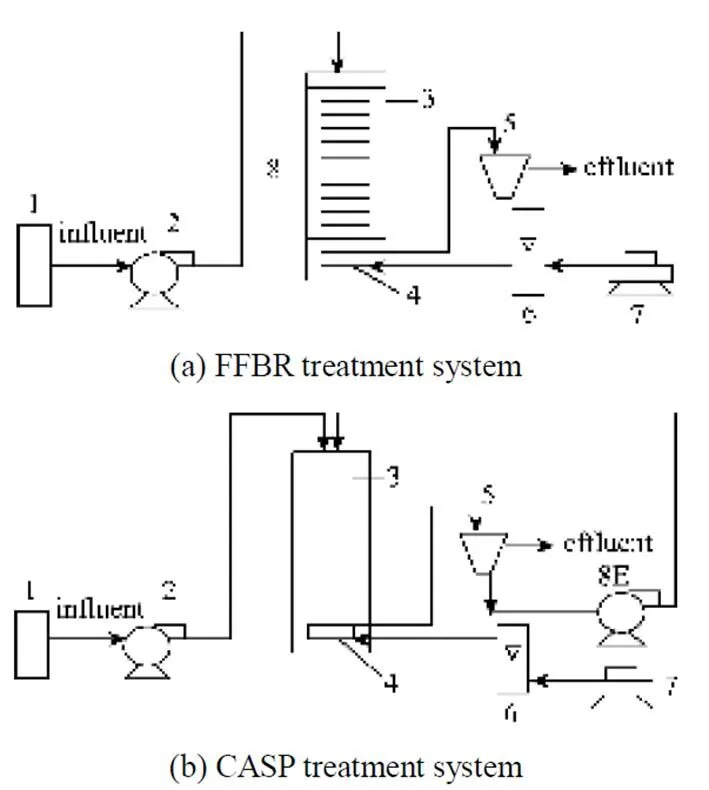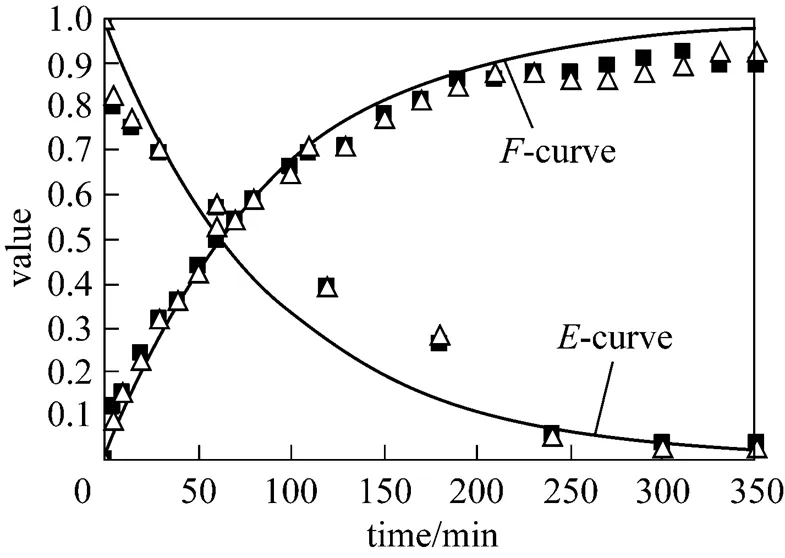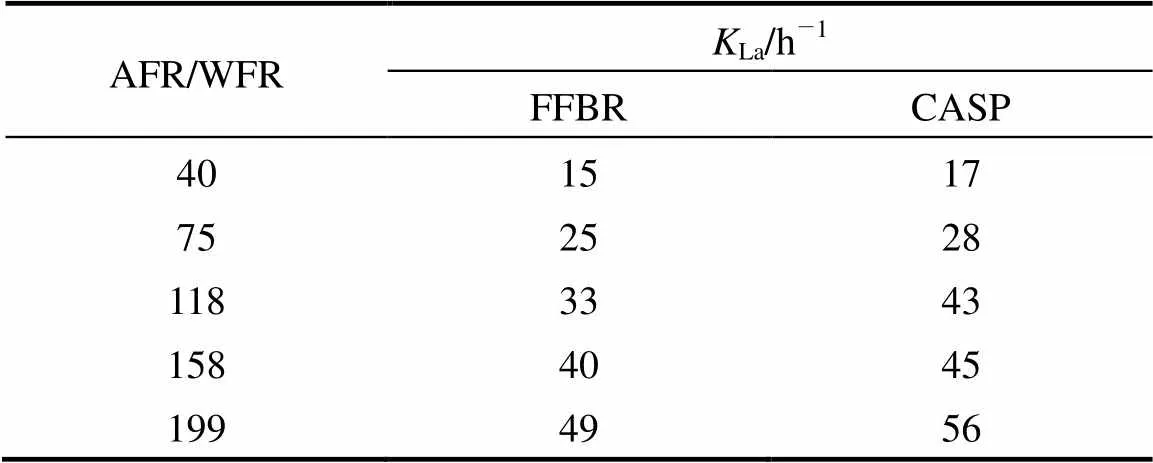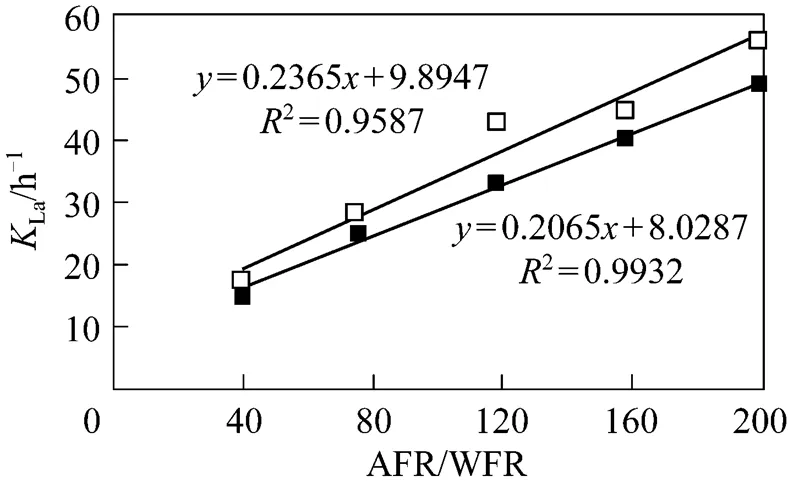Oxygen Transfer and Hydrodynamics in a Flexible Fibre Biofilm Reactor for Wastewater Treatment
2009-05-15CHENYuru陈育如YUJimmy虞启明XUHongwei徐红卫andCHENYan陈雁
CHEN Yuru (陈育如), YU Jimmy (虞启明), XU Hongwei (徐红卫) and CHEN Yan (陈雁)*
Oxygen Transfer and Hydrodynamics in a Flexible Fibre Biofilm Reactor for Wastewater Treatment
CHEN Yuru (陈育如)1, YU Jimmy (虞启明)2, XU Hongwei (徐红卫)2and CHEN Yan (陈雁)3,*
1Jiangsu Engineering and Technology Research Center for Microbiology, College of Life Science, Nanjing Normal University, Nanjing 210046, China2Environmental Engineering, Griffith School of Engineering, Griffith University, Nathan Campus, Brisbane, Queensland 4111, Australia3Institute of Environmental Science, Nanjing Normal University, Nanjing 210097, China
A flexible fibre biofilm reactor was developed for treatment of organic wastewaters. The hydrodynamic characteristics and mass transfer coefficients of oxygen were studied and compared with those of the conventional activated sludge processes. Tracer experiments were performed to obtain the residence time distributions of the reactors. The results indicated that both reactors could be treated as mixed flow reactors. The effects of flow rates of water and air on the overall mass transfer coefficient of oxygen were investigated, and the correlations between the mass transfer coefficient and the ratio of flow rates were obtained. Compared to the conventional activated sludge reactor, the mass transfer coefficients in the flexible fibre reactor were similar to but slightly lower, and less sensitive to the variation in the ratio of flow rates. It indicated that the fibre packing in the reactor hindered the oxygen transfer to some extent.
flexible fibre biofilm reactor, oxygen mass transfer coefficient, activated sludge process, wastewater treatment
1 INTRODUCTION
Food processing industries are increasingly faced with the problem of wastewater treatment before release to municipal wastewater treatment plants or to the receiving environment. These wastewaters have similar characteristics, such as high concentrations of COD or BOD5and total suspended solids [1]. They also contain high levels of nutrients and organic materials. The high levels of COD are in the range 5000 to10000 mg·L-1and the level of BOD5is from 2500 to 6000 mg·L-1. The ratio of BOD5 to COD is generally in the range of 0.5-0.7. The total suspended solids (TSS) generally range between 200 and 3000 mg·L-1[2, 3]. Therefore, most food processing wastewaters are suitable for biological treatment.
The biological methods used for the treatment of food processing wastewater include the conventional activated sludge process (CASP) and biofilm reactors. In all aerobic biological treatments, the dissolved oxygen (DO) level in the water phase is a critical parameter, so that the hydrodynamics and mass transfer of oxygen from the air phase into the water phase play important roles. The mass transfer from a gas phase to a liquid phase is a common phenomenon, and for wastewater treatment processes, many studies have been carried out to investigate the hydrodynamic characteristics and oxygen transfer coefficients using different techniques [4, 5].
Biofilm reactors, based on the conventional activated sludge process, are characteristic of that the microorganisms, such as hyphomycete, actinomycetes and bacteria, exist in a biofilm attached to a support surface. Oxygen transfer coefficients and other parameters are important in design of bioreactors [6-8]. In general, the biofilm can be divided into two zones, the base film and surface film. Both contain an assemblage of microorganisms and other particulate materials bound together by a matrix of extracellular polymers. The relative thickness of the base and surface films depends largely on the hydrodynamic characteristics of the system. Biofilm reactors have many advantages over the conventional activated sludge process, such as operational stability, higher BOD5removal efficiency even at high organic loading rates, and more efficient nitrification [9].
The flexible fibre biofilm reactor (FFBR) has further advantages over other biofilm reactors, including low capital cost, ability to withstand higher organic loading rates, ease control of effluent quality, and no clogging of media. In this study, an FFBR is developed. The hydrodynamic characteristics and mass transfer coefficients of oxygen are studied and compared with those of the conventional activated sludge processes operated under similar conditions. Tracer experiments are performed to obtain the residence time distributions of the reactors. The overall mass transfer coefficients of oxygen are determined at various flow rates of water and air for obtaining their correlations.
2 MATERIALS AND METHODS
2.1 Flexible fibre materials
The flexible fibre was made of rayon fibres, obtained from Environmental Technologies P/L Pty. Co. in Brisbane, Australia, which were bundled and circularly attached to a rope as support at intervals of about 80 mm. The length of the fibre when straightened was about 75 mm and the diameter was 0.07 mm. The rope was attached to a support frame and fixed vertically in the centre of the reactor. The length of the rope used in the experiment was 885 mm and the fibre had a dry mass of 54 g. The fibre packing had a specific contact surface area around 2164 m2·m-3[21.64 m2·(10 L)-1] and a void fraction of more than 99%.
2.2 FFBR and CASP treatment system


Figure 1 Schematic diagram of treatment system
1—equilibrium tank; 2—peristaltic pump; 3—FFBR or CASP; 4—air stone; 5—settling tank; 6—air flow meter; 7—air compressor; 8—fibre; 8E—pump for returning sludge
2.3 Analysis methods
The analytical procedures were in accordance with the Standard Methods for the Examination of Water and Wastewater [6]. The testing factors and analytical methods are presented in Table 1.

Table 1 Testing factors and analytical methods
3 RESULTS AND DISCUSSION
3.1 Distribution of hydraulic retention time
The distribution of hydraulic retention time was determined with two methods:-curve and-curve. In the-curve method, a tracer is instantaneously added into the reactor and the tracer concentration in the effluent is measured as a function of time. The-curve method corresponds to the response curve of the reactor, in which a tracer of concentration0is imposed on the influent entering the reactor using a step input [7].
The-curve for a mixed flow reactor (MFR) is [7]:


The-curve and-curve of the FFBR and CASP were determined experimentally. The influents were tap water controlled at a flow rate (WFR) of 111.2 ml·min-1and the mean residence time was 90 min. For the-curve, food colour solution (4 ml) was directly pulsed into both reactors. The air flow rate was controlled at 221.7 ml·min-1. For the-curve, food colour solution (30 ml) was mixed with 300 ml tap water in the equilibrium tank as an influent. The air was supplied at a flow rate (AFR) of 807 ml·h-1at the bottom of the reactor. The ratio of the AFR to the WFR was 2. The effluent composition was determined by measuring the absorbance with a spectrophotometer (Shimadzu Corporation, UV-1601) at a wavelength of 390 μm at various time intervals.
The results of the tracer experiments, together with the-curve and-curve for MFR calculated from Eqs. (1a) and (1b) are shown in Fig. 2. The experimental data of hydraulic retention time (HRT) in the FFBR and CASP are in agreement with that for mixed flow reactors. The data of HRT in the FFBR and CASP are also extremely close. Therefore, the HRT of the FFBR is not affected by the flexible fibre packing, and in practice, both reactors can be treated as mixed flow reactors under the experimental condition.

Figure 2 Comparison of distribution of hydraulic retention time for FFBR and CASP
—— MFR;■ FFBR;△ CASP
3.2 Oxygen transfer coefficients
The mass transfer rate of oxygen was measured for the FFBR and CASP by using tap water. Nitrogen was supplied to the influent in the equilibrium tank to reduce the content of oxygen to nearly zero. The influent was then pumped into the reactor at a flow rate of 1.2 L·h-1and hydraulic retention time of 8 hours. The air was supplied at flow rates of 48, 90, 142, 190 and 239 L·h-1separately, and the values of AFR/WFR were 40, 75, 118, 158, and 199. For each time interval of 20 seconds, the DO value in the reactor was measured.
Oxygen transfer coefficients were obtained based on the equation presented in the Standard Methods for the Examination of Water and Wastewater [6]. The mass transfer coefficients of oxygen,La, were calculated as follows:



With measured DO concentrations, the overall mass transfer coefficients of oxygen,La, were obtained at five values of AFR/WFR. The linear regression coefficients of ln[s0)/(s)] andare in the range of 0.975-0.997. The mass transfer coefficients of oxygen obtained are summarised in Table 2.
Figure 3 shows the relationship ofLaand AFR/ WFR for the FFBR and CASP,


The effectiveness in the removal of COD and BOD5is related to the aeration/oxygenation capacity during treatment, so that the oxygen transfer is importance [9-11]. Compared to the CASP, the mass transfer coefficients of the FFBR are sightly lower and less sensitive to the variation in the AFR/WFR. Therefore, the presence of the fibre packing hindered the transfer rate of oxygen to some extent. This may be caused by the effect of fibres on the size and distribution of air bubbles. However, the difference in the coefficients is small and may be neglected in applications. The correlation coefficient can be also calculated by using the method proposed by Alexander and Shah [8].

Table 2 Relationship between KLa and AFR/WFR

Figure 3 Relationship between oxygen mass transfer coefficients and AFR/WFR
■ FFBR;□ CASP
This is a primary study on FFBR and further studies are needed for the application in the treatment of food processing wastewaters.
ACKNOWLEGDEMENTS
.
1 Maya-Altamira, L., Baun, A., Angelidaki, I., Schmidt, J.E., “Influenceof wastewater characteristics on methane potential in food-processing industry wastewaters”,., 42 (8/9), 2195-2203 (2008).
2 Xu, H., Yu, Q., “Review of methods for biological treatment of food processing wastewater”, In: Proceedings of the 28th Australian Chemical Engineering Conference (Chemeca’2000), Perth, 9-12 (2000).
3 Cristina, G.F., Pedro, P., Cristina, L.C., Pedro, A., “Solids and nutrients removals from the liquid fraction of swine slurry through screening and flocculation treatment and influence of these processes on anaerobic biodegradability”,., 99 (14), 6233-6239 (2008).
4 Halil, H., Cumali, K., “Comparison of an SMBR with a CASP system for wastewater reclamation and reuse”,, 41 (1), 35-39 (2004).
5 Fikar, M., Chachuat, B., Latifi, M.A., “Optimal operation of alternating activated sludge processes”,, 13 (7), 853-861 (2005).
6 American Public Health Association, Standard Methods for the Examination of Water and Wastewater, 16th edition, American Public Health Association, Washington (1995).
7 Levensipiel, O., Chemical Reaction Engineering, 2nd edition, John Wiley & Sons, New York, 253-315 (1972).
8 Alexander, B.F., Shah, Y.T., “Axial dispersion coefficients in bubble columns”,..., 11, 153-156 (1976).
9 Kubsad, V., Chaudhari, S., Gupta, S.K., “Model for oxygen transfer in rotating biological contactor”,., 38 (20), 4297-4304 (2004).
10 Di Palma, L., Verdone, N., “The effect of disk rotational speed on oxygen transfer in rotating biological contactors”,., 100 (3), 1467-1470 (2009).
11 Martin, M., Montes, F.J., Galan, M.A., “On the contribution of the scales of mixing to the oxygen transfer in stirred tanks”,..., 145 (2), 232-241 (2008).
2008-08-18,
2009-04-03.
* To whom correspondence should be addressed. E-mail: jschenyan@126.com
杂志排行
Chinese Journal of Chemical Engineering的其它文章
- Effect of Relative Humidity on Catalytic Combustion of Toluene over Copper Based Catalysts with Different Supports*
- Prediction of Critical Endpoints Based on the PR Equation of State*
- Kinetic Studies on Wheat Straw Hydrolysis to Levulinic Acid*
- Calculation of Transport Properties of CF4+Noble Gas Mixtures
- Synthesis of 4,4′-MDC in the Presence of Sulfonic Acid-functionalized Ionic Liquids*
- A New Study on Combustion Behavior of Pine Sawdust Characterized by the Weibull Distribution*
